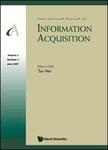版权所有:内蒙古大学图书馆 技术提供:维普资讯• 智图
内蒙古自治区呼和浩特市赛罕区大学西街235号 邮编: 010021

作者机构:Engineering Sector of Broadcast Egyptian Radio and Television Union Egypt Department of Electronics and Electrical Communications Engineering Faculty of Electronic Engineering Menoufia University Menouf 32952 Egypt Computer Engineering Department College of Computer Science and Information Systems Taif University Kingdom of Saudi Arabia Department of Electrical Engineering Faculty of Engineering Albaha University Kingdom of Saudi Arabia Electrical Engineering Department KACST-TIC in Radio Frequency and Photonics for the e-Society (RFTONICS) King Saud University Kingdom of Saudi Arabia KACST-TIC in Radio Frequency and Photonics for the e-Society (RFTONICS) King Saud University Kingdom of Saudi Arabia
出 版 物:《International Journal of Information Acquisition》
年 卷 期:2014年第9卷第3N04期
学科分类:08[工学] 0812[工学-计算机科学与技术(可授工学、理学学位)]
主 题:LEO satellite-cellular telephone-distress signal-voice-data-emergency
摘 要:Low earth orbit (LEO) satellite systems allow a broad range of services to be provided using small, lightweight, cellular-like portable telephones. Exploiting LEO satellites to support distress signals for aircrafts, ships and international travelers is explored in the current paper. A multi-service priority-oriented algorithm is proposed for handling voice, data and emergency signals over LEO satellites. The emergency signal is privileged with service priority so that rescue operation can be carried out as soon as possible. The priority mechanism includes channel reservation as well as joining a queue if no free channel is available as long as the request is roaming in the handover area. In addition, a simplified but efficient approach is suggested for locating the object of an imminent danger situation. As LEO satellites are non-geostationary, the visible period of each spot-beam is small. Consequently, a teletraffic model, that accommodates the mobility of spot-beams as well as the resulting handover rate, is developed in order to gauge the performance of the proposed algorithm. Numerical results for access denying and service-dropping rates are presented for nominal system parameters.